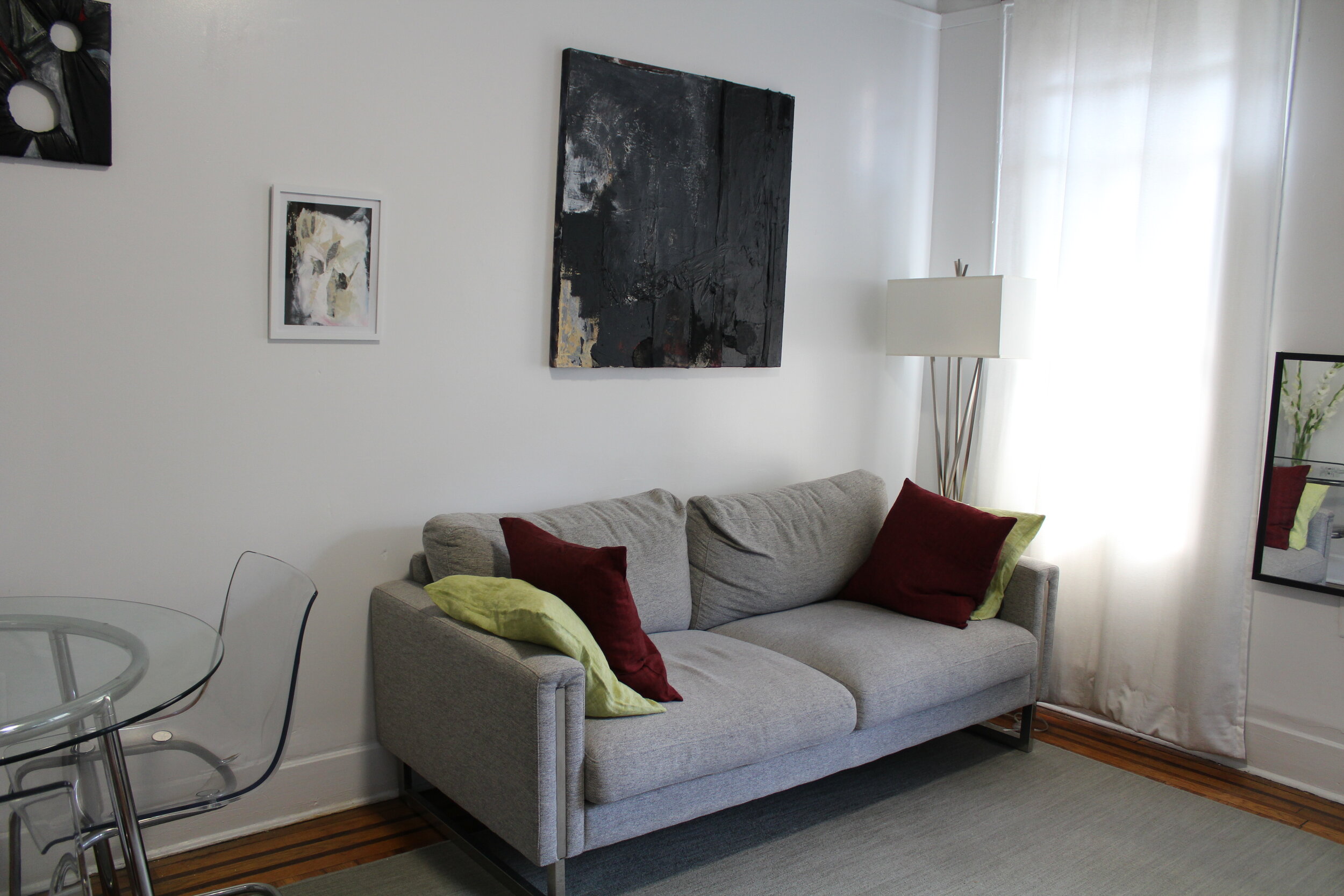OUTSIDE THE RECTANGLE
September 2019
Text and photos by Estelle Pyper
Alex Markwith in his studio
Stepping into local artist Alex Markwith’s apartment on 33rd Street feels like entering a very private gallery. “Curated” with intention, the focus is on Markwith’s paintings -- ranging from large-scale abstracts with hundreds of brush strokes to 3D works jutting out from the walls. One walk around the apartment tells me more about its owner than any other space I’ve visited.
Originally from a small town near Scranton, Pennsylvania, Markwith knew from a young age that he wanted to be an artist. “When I was very young, it was crayons and colored pencils, and I was always inventing my own characters,” Markwith says. “I got into Rhode Island School of Design and I haven’t looked back since.”
Markwith studied painting and English at RISD and moved to New York upon graduation. He landed his first show that summer at a gallery on the Lower East Side. After living and working in Manhattan for three years, he made the move to Astoria with his partner, Meeri Koskialho.
“I didn’t even know where Astoria was prior to then. I never thought about living in Queens,” Markwith remembers. “The community is great. I needed a place that was big enough where I could set up a space where I could work.”
But Markwith needed to stay in New York for the vibrant arts scene. “New York was historically, and maybe still is, the center of the art world, globally,” he says. “ It has a lot going on for visual arts that started in the ‘60s and ‘70s. There are more galleries here, there are more opportunities, but on the flip side, it’s more difficult as an artist because it’s more expensive and you’re going to have less space.”
Markwith describes his work as abstract and “mixed media” -- meaning he creates his pieces using layers of found materials such as cardboard, wire, netting, twine, leather, and even Caution Tape.
And nothing gives you a better sense of his work than walking down his apartment’s long hallway entrance. Stacked canvases are pushed up against the wall and the ones that couldn’t fit due to their 3D nature are hung in the narrow space. One of his favorites, “Cloak of Self Expression” (2013), a small canvas wrapped in remnants of a leather jacket, sits right at eye level. It’s been shown in several cities but Markwith has no intention of selling it.
“I don’t start with a preconceived idea of what I’m going to make,” says Markwith. “It’s more a process of trying this and trying that and seeing what works. I start in my own head and I’m responding to the way I compare different elements. It’s almost a process of sculpture even though they’re hanging on the wall.”
The main living space is more intentional. The furniture is minimal, modern and neutral-based -- the only color coming from the red and yellow throw pillows on the couch. Markwith and Koskialho purposefully decorated in this way to allow the busy art in the room to take center stage.
“Meeri and I both like this concept of minimalism. There was even a question of having these colored pillows here,” says Markwith. “But generally neutral decor is best. With interior design, I think mixing textures is the most important thing -- sticking to one color palette, but then mixing textures.”
“One of the biggest limitations in painting is that you always have a rectangle,” Markwith says. “Breaking up the rectangle gives it its own character. With each work, I want it to have its own character. I want to make something you haven’t seen before.”
The bedroom has a similar layout: a simple white low-set bed with side tables and two large canvases on opposite sides of the space. One is filled with straight black and white brush strokes, and the other is more chaotic, with specks of neon paint peeping through the white and black paint smear, topped off with twine stuck on top. You could look at it for hours.
“I want to make something that surprises me,” says the artist. “The most difficult part is recognizing when the work is finished, because the nature is such that one could continue just on one canvas but that would not very fulfilling to me. I need to see a result at some point.”
The kitchen also serves as a display room. One wall features a large canvas with more leather jacket pieces. The opposite wall is covered in smaller abstract works covered in found materials. The kitchen used to double as his physical studio before he got a space of his own. Now, his studio is only a short walk away.
His studio is a behind-the-scenes view into Markwith’s creative process. The modest space is an art teacher’s dream -- the shelves are stacked with supplies and boxes are busting with materials in every corner.
“I get ideas from the materials, so the materials are directly related to what’s produced,” he says. “It’s a studio practice. It’s something like with yoga -- you commit to doing it and you have to spend time in the studio. The work’s always developing.”
You can catch some Markwith originals today, right around the corner in Long Island City, at Plaxall Gallery from September 8th - October 12th. Two new pieces of his, “Orange Void” and “Quadruple void” will be shown.
Originally published in the September 2019 issue of BORO magazine









